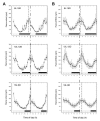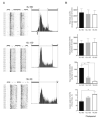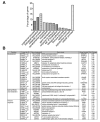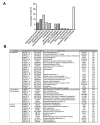Photoperiodic modulation of adrenal gland function in the rhesus macaque: effect on 24-h plasma cortisol and dehydroepiandrosterone sulfate rhythms and adrenal gland gene expression
- PMID: 19223397
- PMCID: PMC2746829
- DOI: 10.1677/JOE-08-0437
Photoperiodic modulation of adrenal gland function in the rhesus macaque: effect on 24-h plasma cortisol and dehydroepiandrosterone sulfate rhythms and adrenal gland gene expression
Abstract
In temperate zones, day length changes markedly across the year, and in many mammals these photoperiodic variations are associated with physiological adaptations. However, the influence of this environmental variable on human behavior and physiology is less clear, and the potential underlying mechanisms are unknown. To address this issue, we examined the effect of changing photoperiods on adrenal gland function in ovariectomized female rhesus macaques (Macaca mulatta), both in terms of steroid hormone output and in terms of gene expression. The animals were sequentially exposed to the following lighting regimens, which were designed to simulate photoperiods associated with winter, spring/autumn and summer respectively: 8 h light:16 h darkness (short days), 12 h light:12 h darkness and 16 h light:8 h darkness (long days). Remote 24-h serial blood sampling failed to disclose any effect of photoperiod on mean or peak plasma levels of cortisol or dehydroepiandrosterone sulfate. However, there was a marked phase-advancement of both hormonal rhythms in short days, which was reflected as a similar phase-advancement of the daily motor activity rhythm. Gene microarray analysis of the adrenal gland transcriptome revealed photoperiod-induced differences in the expression of genes associated with homeostatic functions, including: development, lipid synthesis and metabolism, and immune function. Taken together, the results indicate that in primates, both circadian adrenal physiology and gene expression are influenced by seasonal changes in day length, which may have implications for adrenal-regulated physiology and behavior.
Conflict of interest statement
The authors declare that there was no conflict of interest that would prejudice the impartiality of the research reported.
Figures





Similar articles
-
Twenty-four-hour rhythmic gene expression in the rhesus macaque adrenal gland.Mol Endocrinol. 2006 May;20(5):1164-76. doi: 10.1210/me.2005-0361. Epub 2006 Jan 26. Mol Endocrinol. 2006. PMID: 16439464
-
Fetectomy alters maternal pituitary-adrenal function in pregnant rhesus macaques.Biol Reprod. 2001 Nov;65(5):1616-21. doi: 10.1095/biolreprod65.5.1616. Biol Reprod. 2001. PMID: 11673283
-
Feeding and adrenal entrainment stimuli are both necessary for normal circadian oscillation of peripheral clocks in mice housed under different photoperiods.Chronobiol Int. 2015 Mar;32(2):195-210. doi: 10.3109/07420528.2014.962655. Epub 2014 Oct 6. Chronobiol Int. 2015. PMID: 25286135
-
Dehydroepiandrosterone sulfate (DHEAS) as an endocrine marker of aging in calorie restriction studies.Exp Gerontol. 2013 Oct;48(10):1136-9. doi: 10.1016/j.exger.2013.01.001. Epub 2013 Jan 11. Exp Gerontol. 2013. PMID: 23318475 Free PMC article. Review.
-
Encoding time of day and time of year by the avian circadian system.J Neuroendocrinol. 2003 Apr;15(4):398-404. doi: 10.1046/j.1365-2826.2003.01003.x. J Neuroendocrinol. 2003. PMID: 12622840 Review.
Cited by
-
Age-related changes in neuroendocrine rhythmic function in the rhesus macaque.Age (Dordr). 2012 Oct;34(5):1111-21. doi: 10.1007/s11357-011-9352-z. Epub 2011 Dec 25. Age (Dordr). 2012. PMID: 22198672 Free PMC article. Review.
-
Photoperiodic Effects on Diurnal Rhythms in Cell Numbers of Peripheral Leukocytes in Domestic Pigs.Front Immunol. 2019 Mar 12;10:393. doi: 10.3389/fimmu.2019.00393. eCollection 2019. Front Immunol. 2019. PMID: 30915069 Free PMC article.
-
Feasibility of successfully breeding rhesus macaques (Macaca mulatta) to obtain healthy infants year-round.Am J Primatol. 2020 Jan;82(1):e23085. doi: 10.1002/ajp.23085. Epub 2019 Dec 25. Am J Primatol. 2020. PMID: 31875991 Free PMC article.
-
The ticking clock of Cayo Santiago macaques and its implications for understanding human circadian rhythm disorders.Am J Primatol. 2016 Jan;78(1):117-26. doi: 10.1002/ajp.22413. Epub 2015 May 1. Am J Primatol. 2016. PMID: 25940511 Free PMC article. Review.
-
Endocrine rhythms in the brown bear (Ursus arctos): Evidence supporting selection for decreased pineal gland size.Physiol Rep. 2013 Aug;1(3):e00048. doi: 10.1002/phy2.48. Epub 2013 Aug 22. Physiol Rep. 2013. PMID: 24303132 Free PMC article.
References
-
- Agrimonti F, Angeli A, Frairia R, Fazzari A, Tamagnone C, Fornaro D, Ceresa F. Circannual rhythmicities of cortisol levels in the peripheral plasma of healthy subjects. Chronobiologia. 1982;9:107–114. - PubMed
-
- Baker JR. The evolution of breeding season. In: de Beer GR, editor. Evolution (Essays presented to E.S. Goodrich. Oxford University Press; London: 1938. pp. 161–177.
Publication types
MeSH terms
Substances
Grants and funding
LinkOut - more resources
Full Text Sources

